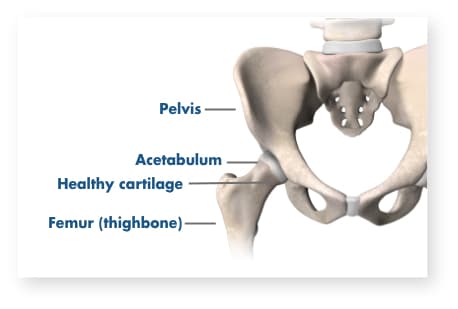Why do I have hip pain?
To help you get a better idea of why your hip hurts, let’s take a look at how it works. Your hip is actually a ball-and-socket joint where the femur (thighbone) meets the pelvis. The top of the femur has a rounded head that fits into a cup-like socket in the pelvis called the acetabulum. When it’s working smoothly, you don’t think about the mechanics of your hip joint. When something’s wrong, it can feel so debilitating that it becomes the only thing on your mind.

Understanding arthritis
Your hip pain may be due to chronic swelling or inflammation in the joint – most often referred to as arthritis. The most common forms of arthritis associated with hip pain are osteoarthritis (sometimes called wear-and-tear arthritis) and rheumatoid arthritis (a systemic auto-immune disease).
With osteoarthritis, the cushioning cartilage at the end of the femur may have worn down, making walking painful as bone rubs against bone.1
With rheumatoid arthritis, sometimes called inflammatory arthritis, a person’s immune system attacks the joints with uncontrolled inflammation, potentially causing joint erosion.2
With post-traumatic arthritis, a less common form of arthritis, a broken or fractured bone extends into the joint space, causing the surface to become uneven. Over time, friction causes the joint to break down and become arthritic.1
Talk to your doctor
Every doctor is different, but many follow a similar approach to diagnose your hip pain. At your first appointment, your orthopaedic doctor will ask you a few questions about when and where your hip hurts to assess what’s going on. The doctor may ask you to bend and turn to imitate the movements that may be causing you pain. They may understand what’s going on right away because you show classic symptoms of a particular problem, or they may also ask you to have an additional diagnostic test, like an X-ray or an MRI.
Pain relief doesn’t always mean surgery. Your doctor may recommend a combination of treatments to alleviate your pain and help you get moving again. Learn more about your options
References:
- American Academy of Orthopaedic Surgeons. Treatment: Total Hip Replacement. OrthoInfo. orthoinfo.aaos.org/en/treatment/total-hip-replacement. Accessed 26 March 2018.
- Arthritis Foundation. Rheumatoid Arthritis. https://www.arthritis.org/about-arthritis/types/rheumatoid-arthritis/. Accessed 5 November 2018.
U.S. Modular Hip Settlement Program
Stryker's Voluntary Recall of Rejuvenate and ABG II Modular-Neck Hip Stems
Hip Replacements
Hip joint replacement is intended for use in individuals with joint disease resulting from degenerative and rheumatoid arthritis, avascular necrosis, fracture of the neck of the femur or functional deformity of the hip.
Joint replacement surgery is not appropriate for patients with certain types of infections, any mental or neuromuscular disorder which would create an unacceptable risk of prosthesis instability, prosthesis fixation failure or complications in postoperative care, compromised bone stock, skeletal immaturity, severe instability of the joint, or excessive body weight.
Like any surgery, joint replacement surgery has serious risks which include, but are not limited to, pain, infection, bone fracture, change in the treated leg length (hip), joint stiffness, hip joint fusion, amputation, peripheral neuropathies (nerve damage), circulatory compromise (including deep vein thrombosis (blood clots in the legs)), genitourinary disorders (including kidney failure), gastrointestinal disorders (including paralytic ileus (loss of intestinal digestive movement)), vascular disorders (including thrombus (blood clots), blood loss, or changes in blood pressure or heart rhythm), bronchopulmonary disorders (including emboli, stroke or pneumonia), heart attack, and death.
Implant related risks which may lead to a revision of the implant include dislocation, loosening, fracture, nerve damage, heterotopic bone formation (abnormal bone growth in tissue), wear of the implant, metal and/or foreign body sensitivity, soft tissue imbalance, osteolysis (localized progressive bone loss), audible sounds during motion, and reaction to particle debris. Hip implants may not provide the same feel or performance characteristics experienced with a normal healthy joint.
The information presented is for educational purposes only. Speak to your doctor to decide if joint replacement surgery is appropriate for you. Individual results vary and not all patients will return to the same activity level. The lifetime of any joint replacement is limited and depends on several factors like patient weight and activity level. Your doctor will counsel you about strategies to potentially prolong the lifetime of the device, including avoiding high-impact activities, such as running, as well as maintaining a healthy weight. It is important to closely follow your doctor’s instructions regarding post-surgery activity, treatment and follow-up care. Ask your doctor if a joint replacement is right for you.
Stryker Corporation or its other divisions or other corporate affiliated entities own, use or have applied for the following trademarks or service marks: Mako, Mobile Bearing Hip, Stryker, Together with our customers, we are driven to make healthcare better. All other trademarks are trademarks of their respective owners or holders.
JR-OTH-WEB-560450